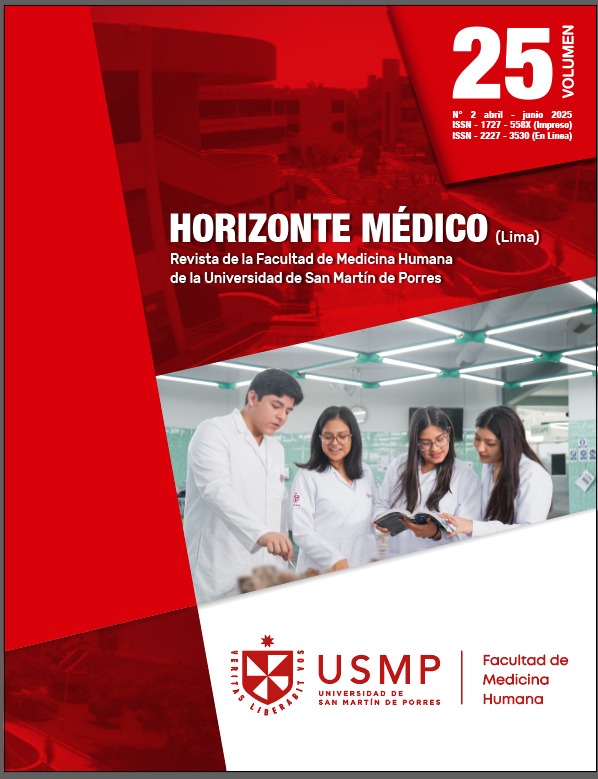Paracoccidioidomycosis and HTLV-1 infection: incidental coexistence? A case report
DOI:
https://doi.org/10.24265/horizmed.2025.v25n2.17Keywords:
Paracoccidioidomycosis, Human T-lymphotropic virus 1, CoinfectionAbstract
Paracoccidioidomycosis is a systemic mycosis, endemic to Latin America, caused by the dimorphic
fungus Paracoccidioides spp., mainly acquired through the inhalation of spores present in the
environment. It predominantly affects males in rural areas due to their frequent exposure to
contaminated soil. Following primary infection, the pathogen has the potential to spread via
hematogenous or lymphatic routes, involving various organs and systems. The acute form of
paracoccidioidomycosis impairs peripheral T-cell function and disrupts neutrophil maturation,
while the chronic form is characterized by a progressive decline of the cellular immune response,
along with increased Th1-cytokine levels. Severe cases may present with hypergammaglobulinemia,
reduced phagocytic capacity and immune dysregulation. The most significant risk factors include
prior immunosuppression and infectious comorbidities, such as retroviral coinfections. We present
the case of a 68-year-old male with chronic disseminated paracoccidioidomycosis and HTLV-1
coinfection. The patient exhibited mucocutaneous lesions, extensive pulmonary involvement
and significant adrenal impairment, indicating the invasive capacity of Paracoccidioides spp.
and the adverse impact of coinfection on immunity. Initial treatment with amphotericin B was
administered; however, the patient developed multiple organ failure, resulting in a fatal outcome.
This case highlights the need for a comprehensive approach to the diagnosis and treatment of disseminated mycoses in immunocompromised patients, particularly in endemic regions. It also emphasizes the importance of
considering coinfections, such as HTLV-1, which can modify the clinical course, worsen the prognosis and increase mortality in these complex diseases.
Downloads
References
Zerbato V, Di Bella S, Pol R, D'Aleo F, Angheben A, Farina C, et al. Endemic Systemic Mycoses in Italy: A Systematic Review of Literature and a Practical Update. Mycopathologia. 2023;188(4):307-334. doi: 10.1007/s11046-023-00735-z.
Zurita Macalupú S. Esporotricosis y paracoccidioidomicosis en Perú: experiencias en prevención y control. Rev Peru Med Exp Salud Publica. 2014;31(2):352-7. doi: 10.17843/rpmesp.2014.312.58
de Macedo PM, Teixeira M de M, Barker BM, Zancopé-Oliveira RM, Almeida-Paes R, Francesconi do Valle AC. Clinical features and genetic background of the sympatric species Paracoccidioides brasiliensis and Paracoccidioides americana. PLoS Negl Trop Dis. 2019;13(4):e0007309. doi: 10.1371/journal.pntd.0007309
Cordova LA, Torres J. Paracoccidioidomycosis. [Updated 2022 Sep 19]. In: StatPearls [Internet]. Treasure Island (FL): StatPearls Publishing; 2024 [cited 09 december 2024]. Available from: http://www.ncbi.nlm.nih.gov/books/NBK563188/
Sousa C, Marchiori E, Youssef A, Mohammed TL, Patel P, Irion K, et al. Chest Imaging in Systemic Endemic Mycoses. J Fungi (Basel). 2022;8(11):1132. doi: 10.3390/jof8111132.
Montenegro-Idrogo J, Chiappe-Gonzalez A, Vicente-Lozano E, Cornejo-Venegas G, Resurrección-Delgado C. Case Report: Disseminated Paracoccidioidomycosis and Strongyloides Hyperinfection in a Patient with Human T-Lymphotropic Virus Type 1/2 Infection. Am J Trop Med Hyg. 2024;110(5):961-4. doi: 10.4269/ajtmh.23-0171.
de Oliveira LLC, de Arruda JAA, Marinho MFP, Cavalcante IL, Abreu LG, Abrahão AC, et al. Oral paracoccidioidomycosis: a retrospective study of 95 cases from a single center and literature review. Med Oral Patol Oral Cir Bucal. 2023;28(2):e131-e139. doi: 10.4317/medoral.25613.
Wagner G, Moertl D, Glechner A, Mayr V, Klerings I, Zachariah C, et al. Paracoccidioidomycosis Diagnosed in Europe—A Systematic Literature Review. J Fungi. 2021;7(2):157. doi: 10.3390/jof7020157.
Ribeiro SM, Nunes TF, Cavalcante RS, Paniago AMM, Pereira BAS, Mendes RP. A scoping study of pulmonary paracoccidioidomycosis: severity classification based on radiographic and tomographic evaluation. J Venom Anim Toxins Incl Trop Dis. 2022;28:e20220053. doi: 10.1590/1678-9199-JVATITD-2022-0053.
Peçanha P, Peçanha-Pietrobom P, Grão-Velloso TR, Júnior MR, Falqueto A, Gonçalves SS. Paracoccidioidomycosis: What We Know and What Is New in Epidemiology, Diagnosis, and Treatment. J Fungi. 2022;8(10):1098. doi: 10.3390/jof8101098.
de Oliveira FM, Fragoso MCBV, Meneses AF, Vilela LAP, Almeida MQ, Palhares RB, et al. Adrenal insufficiency caused by paracoccidioidomycosis: three case reports and review. AACE Clin Case Rep. 2019;5(4):e238. doi: 10.4158/ACCR-2018-0632.
Ratner L. Molecular biology of human T cell leukemia virus. Semin Diagn Pathol. 2019;37(2): 104-109. doi: 10.1053/j.semdp.2019.04.003.
Legrand N, McGregor S, Bull R, Bajis S, Valencia BM, Ronnachit A, et al. Clinical and Public Health Implications of Human T-Lymphotropic Virus Type 1 Infection. Clin Microbiol Rev. 2022;35(2):e0007821. doi: 10.1128/cmr.00078-21.
Caterino-de-Araujo A, Campos KR, Alves IC, Vicentini AP. HTLV-1 and HTLV-2 infections in patients with endemic mycoses in São Paulo, Brazil: A cross-sectional, observational study. Lancet Reg Health Am. 2022;15:100339. doi: 10.1016/j.lana.2022.100339.
Shikanai-Yasuda MA, Conceição YMT, Kono A, Rivitti E, Campos AF, Campos SV. Neoplasia and paracoccidioidomycosis. Mycopathologia. 2008;165(4-5):303-12. doi: 10.1007/s11046-007-9047-2.
Published
How to Cite
Issue
Section
License
Copyright (c) 1970 Horizonte Médico (Lima)

This work is licensed under a Creative Commons Attribution 4.0 International License.
Horizonte Médico (Lima) (Horiz. Med.) journal’s research outputs are published free of charge and are freely available to download under the open access model, aimed at disseminating works and experiences developed in biomedical and public health areas, both nationally and internationally, and promoting research in the different fields of human medicine. All manuscripts accepted and published in the journal are distributed free of charge under the terms of a Creative Commons license – Attribution 4.0 International (CC BY 4.0).


















